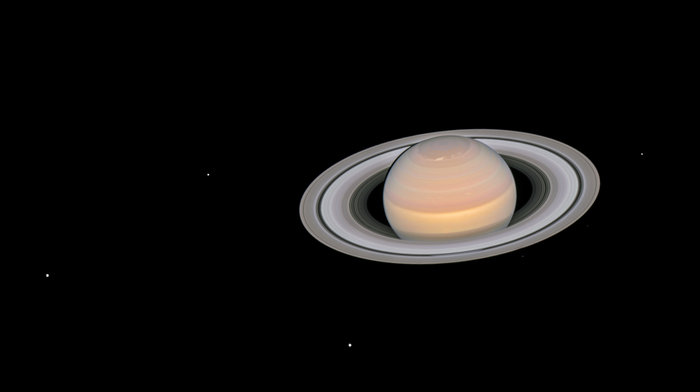

View larger. | June 6, 2018 composite image of Saturn and its moons via ESA/ Hubble.
The Hubble Space Telescope captured this composite image of Saturn on June 6, 2018, shortly before the ringed planet reached its opposition for this year. In other words, it caught Saturn around the time Earth and Saturn were closest for 2018. ESA, which released this image on September 10, said:
The image shows Saturn with six of its 62 known moons. From left to right, the moons visible in this image are Dione, Enceladus, Tethys, Janus, Epimetheus, and Mimas. The moons seen here are all icy and cratered. Enceladus is considered a candidate for the existence of primitive life because it is outgassing water vapour from a subsurface ocean. Based on data from the Cassini mission to Saturn, scientists hypothesise that a small, wayward moon like one of these disintegrated 200 million years ago to form Saturn’s ring system.
The image is a composite because the moons move during the Saturn exposures, and individual frames must be realigned to make a color portrait.
Bottom line: Hubble Space Telescope composite image of Saturn, acquired June 6, 2018.
Read more: It’s been a year since Cassini plunged into Saturn
from EarthSky https://ift.tt/2Muv1bx


View larger. | June 6, 2018 composite image of Saturn and its moons via ESA/ Hubble.
The Hubble Space Telescope captured this composite image of Saturn on June 6, 2018, shortly before the ringed planet reached its opposition for this year. In other words, it caught Saturn around the time Earth and Saturn were closest for 2018. ESA, which released this image on September 10, said:
The image shows Saturn with six of its 62 known moons. From left to right, the moons visible in this image are Dione, Enceladus, Tethys, Janus, Epimetheus, and Mimas. The moons seen here are all icy and cratered. Enceladus is considered a candidate for the existence of primitive life because it is outgassing water vapour from a subsurface ocean. Based on data from the Cassini mission to Saturn, scientists hypothesise that a small, wayward moon like one of these disintegrated 200 million years ago to form Saturn’s ring system.
The image is a composite because the moons move during the Saturn exposures, and individual frames must be realigned to make a color portrait.
Bottom line: Hubble Space Telescope composite image of Saturn, acquired June 6, 2018.
Read more: It’s been a year since Cassini plunged into Saturn
from EarthSky https://ift.tt/2Muv1bx

Aucun commentaire:
Enregistrer un commentaire